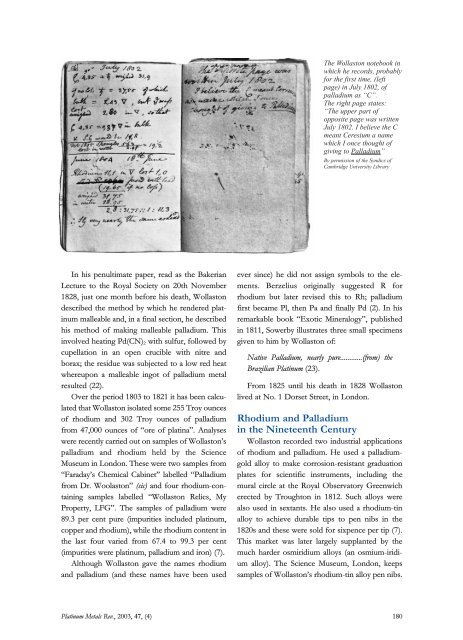Bicentenary of Four Platinum Group Metals - Platinum Metals Review
Bicentenary of Four Platinum Group Metals - Platinum Metals Review
Bicentenary of Four Platinum Group Metals - Platinum Metals Review
You also want an ePaper? Increase the reach of your titles
YUMPU automatically turns print PDFs into web optimized ePapers that Google loves.
The Wollaston notebook in<br />
which he records, probably<br />
for the first time, (left<br />
page) in July 1802, <strong>of</strong><br />
palladium as “C”.<br />
The right page states:<br />
“The upper part <strong>of</strong><br />
opposite page was written<br />
July 1802. I believe the C<br />
meant Ceresium a name<br />
which I once thought <strong>of</strong><br />
giving to Palladium”<br />
By permission <strong>of</strong> the Syndics <strong>of</strong><br />
Cambridge University Library<br />
In his penultimate paper, read as the Bakerian<br />
Lecture to the Royal Society on 20th November<br />
1828, just one month before his death, Wollaston<br />
described the method by which he rendered platinum<br />
malleable and, in a final section, he described<br />
his method <strong>of</strong> making malleable palladium. This<br />
involved heating Pd(CN) 2 with sulfur, followed by<br />
cupellation in an open crucible with nitre and<br />
borax; the residue was subjected to a low red heat<br />
whereupon a malleable ingot <strong>of</strong> palladium metal<br />
resulted (22).<br />
Over the period 1803 to 1821 it has been calculated<br />
that Wollaston isolated some 255 Troy ounces<br />
<strong>of</strong> rhodium and 302 Troy ounces <strong>of</strong> palladium<br />
from 47,000 ounces <strong>of</strong> “ore <strong>of</strong> platina”. Analyses<br />
were recently carried out on samples <strong>of</strong> Wollaston’s<br />
palladium and rhodium held by the Science<br />
Museum in London. These were two samples from<br />
‘‘Faraday’s Chemical Cabinet’’ labelled “Palladium<br />
from Dr. Woolaston” (sic) and four rhodium-containing<br />
samples labelled “Wollaston Relics, My<br />
Property, LFG”. The samples <strong>of</strong> palladium were<br />
89.3 per cent pure (impurities included platinum,<br />
copper and rhodium), while the rhodium content in<br />
the last four varied from 67.4 to 99.3 per cent<br />
(impurities were platinum, palladium and iron) (7).<br />
Although Wollaston gave the names rhodium<br />
and palladium (and these names have been used<br />
ever since) he did not assign symbols to the elements.<br />
Berzelius originally suggested R for<br />
rhodium but later revised this to Rh; palladium<br />
first became Pl, then Pa and finally Pd (2). In his<br />
remarkable book “Exotic Mineralogy”, published<br />
in 1811, Sowerby illustrates three small specimens<br />
given to him by Wollaston <strong>of</strong>:<br />
Native Palladium, nearly pure............(from) the<br />
Brazilian <strong>Platinum</strong> (23).<br />
From 1825 until his death in 1828 Wollaston<br />
lived at No. 1 Dorset Street, in London.<br />
Rhodium and Palladium<br />
in the Nineteenth Century<br />
Wollaston recorded two industrial applications<br />
<strong>of</strong> rhodium and palladium. He used a palladiumgold<br />
alloy to make corrosion-resistant graduation<br />
plates for scientific instruments, including the<br />
mural circle at the Royal Observatory Greenwich<br />
erected by Troughton in 1812. Such alloys were<br />
also used in sextants. He also used a rhodium-tin<br />
alloy to achieve durable tips to pen nibs in the<br />
1820s and these were sold for sixpence per tip (7).<br />
This market was later largely supplanted by the<br />
much harder osmiridium alloys (an osmium-iridium<br />
alloy). The Science Museum, London, keeps<br />
samples <strong>of</strong> Wollaston’s rhodium-tin alloy pen nibs.<br />
<strong>Platinum</strong> <strong>Metals</strong> Rev., 2003, 47, (4) 180
















